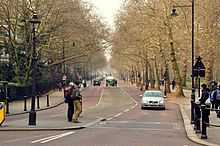Birdcage Walk

Birdcage Walk is a street in the City of Westminster in London. It runs east-west as a continuation of Great George Street, from the crossroads with Horse Guards Road and Storey's Gate, with the Treasury building and the Institution of Mechanical Engineers on the northeast corner, to a junction with Buckingham Gate, at the southeast corner of Buckingham Palace. St. James's Park lies to the north, whilst to the south are the backs of buildings on Old Queen Street, Queen Anne's Gate and Petty France, and, at the western end, the Wellington Barracks of the Brigade of Guards.
The street is named after the Royal Menagerie and Aviary which were located there in the reign of King James I. King Charles II expanded the Aviary when the Park was laid out from 1660. Samuel Pepys and John Evelyn both mention visiting the Aviary in their diaries.[1][2] Storey's Gate, named after Edward Storey, Keeper of the Kings Birds at the time of Pepys, was originally the gate at the eastern end of Birdcage Walk: the name is now applied to the street leading from the eastern end to Westminster Abbey, which was formerly called Prince's Street.[3]
Only the British Royal Family and the Hereditary Grand Falconer, the Duke of St Albans, were permitted to drive along the road until 1828, when it was opened to the public.[3] By the mid-19th century, the walk had gained notoriety as a cruising ground for homosexual trysts.[4] A new roundabout was built at the western end in 1903.[5]
Birdcage Walk is the name of a march composed in 1951 by Arnold Steck. It was the name of a street in Bethnal Green, now called Columbia Road,[6][7] and is also the name of a road on the Mackworth Estate in Derby.
Birdcage Walk forms part of the marathon course of the 2012 Olympic and Paralympic Games. The women's Olympic marathon took place on 5 August and the men's Olympic marathon on 12 August. The Paralympic marathons were held on 9 September.[8][9]
References
- ↑ This entry from 18 August 1661 mentions "and then to walk in St. James’s Park, and saw great variety of fowl which I never saw before".
- ↑ An entry is quoted in The Book of Duck Decoys, their construction, management, and history, Sir Ralph Payne-Gallwey, Bt., Chapter 9, page 127: "...Evelyn's Diary, March 29, 1665. He says, "I went to St. James' Park, where I saw various animals, and examined the throat of ye 'Onocratylus,' or Pelican, a fowle between a Stork and a Swan, a melancholy waterfowl brought from Astracan by the Russian Ambassador; it was diverting to see how he would toss up and turn a flat fish, plaice or flounder, to get it right into its gullet..."
- ↑ 3.0 3.1 Westminster: St. James's Park, Old and New London: Volume 4 (1878), pp. 47-60.
- ↑ Rictor Norton, "A History of Gay Sex", Gay History and Literature, 24 November 2006. Ironically, this street is mentioned in Somerset Maugham's semi-autobiographical masterpiece, "Of Human Bondage," when the novel's protagonist, Philip, decides to marry. Maugham, of course, was gay. Accessed 1 December 2010.
- ↑ Simon Bradley and Nikolaus Pevsner, "The Buildings of England: London 6: Westminster" (Yale University Press, 2003), p. 654.
- ↑ http://www.british-history.ac.uk/report.aspx?compid=22748
- ↑ http://www.mappalondon.com/london/north-east/spitalfields.jpg
- ↑ http://www.london2012.com/athletics/event/men-marathon/coursemap/
- ↑ http://www.london2012.com/athletics/event/women-marathon/coursemap/
Coordinates: 51°30′03″N 0°08′06″W / 51.50083°N 0.13500°W
| Wikimedia Commons has media related to Birdcage Walk. |